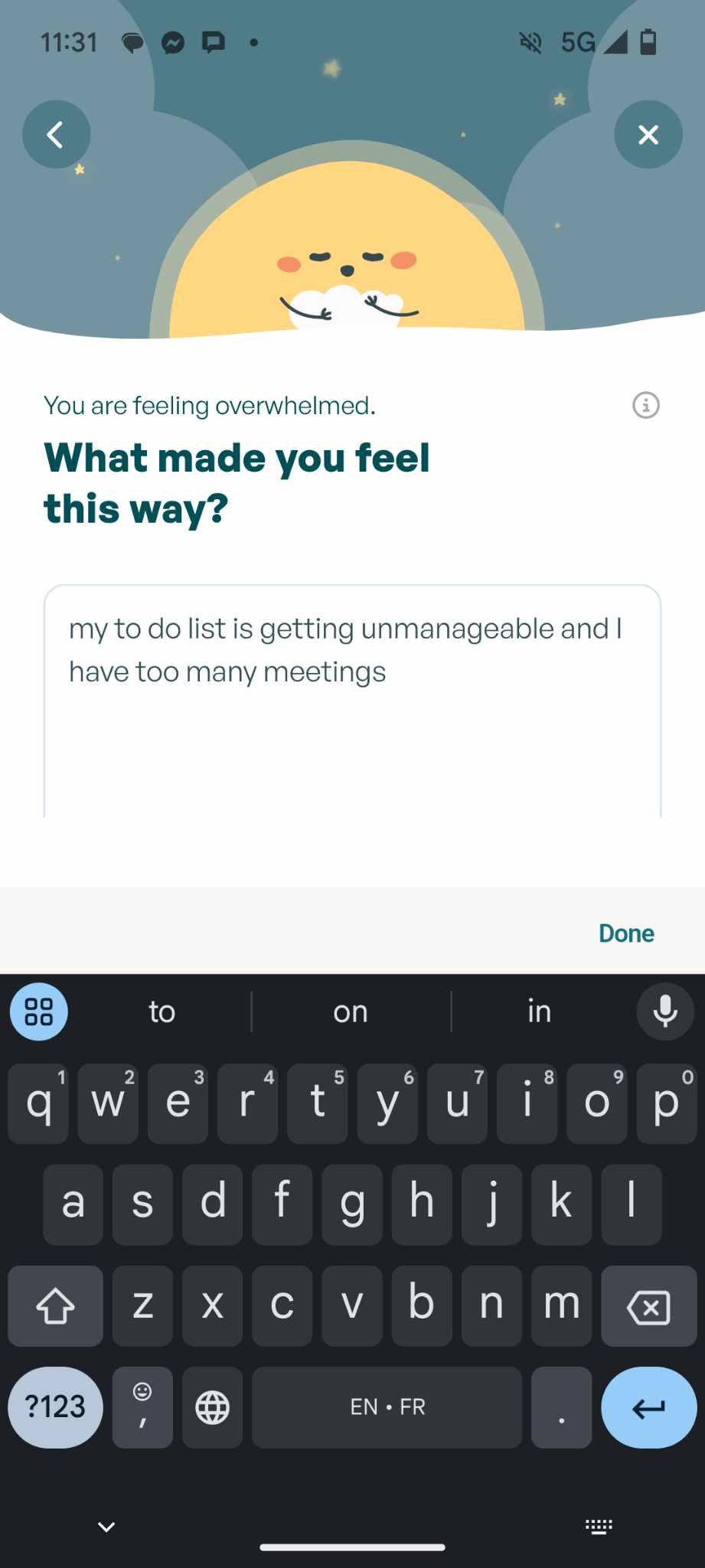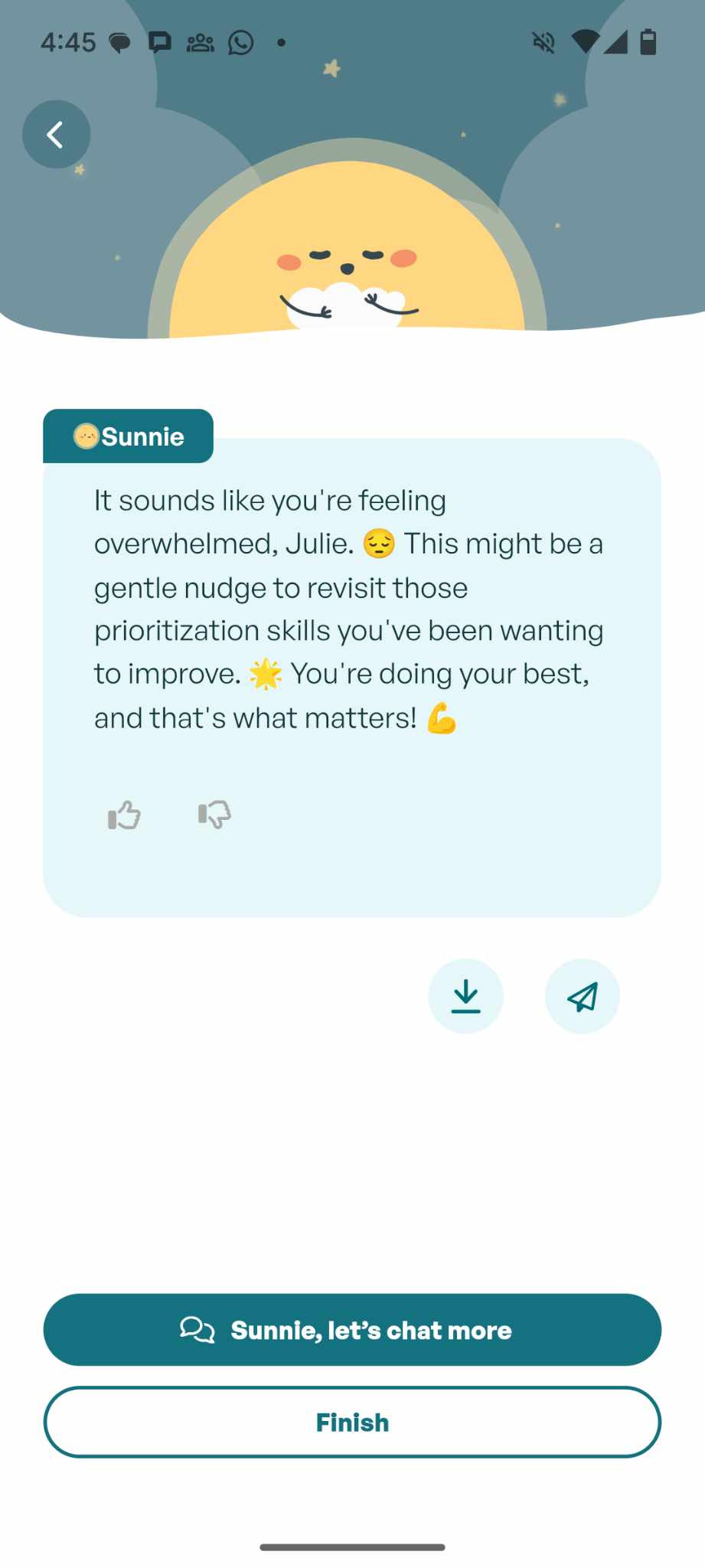How to Leverage AI for Emotional Wellness
A three-step approach to emotion regulation: awareness, insight, and action.
It’s Tuesday morning. As I sit down to start my day, the weight of my to-do list starts pressing in, leaving me feeling overwhelmed.
So I open ChatGPT and type, “I’m feeling overwhelmed.”
After offering a brief message of empathy, ChatGPT provides a list of actions to try—everything from taking a deep breath to reaching out to someone. This is the magic of AI—it's not just accessible, it’s also packed with helpful ideas. But here’s the problem: despite getting this list, I still feel overwhelmed (if not more!).
Why?
The Potential (and Limits) of AI
As AI tools like ChatGPT become increasingly integrated into our lives, many people are turning to them to gain a new perspective, talk through challenges, or for emotional support. And the benefits are clear:
They’re available 24/7
They have a vast repository of knowledge
Recent studies have found that they can be even better than humans at providing emotional support!
Yet, while AI can deliver great advice, there's a big difference between receiving information and acting on it. According to affective science, psychology, and behavioral science, getting there requires several more steps.
This is where our backgrounds in psychology and human-centered design come in. At Flourish Science, we’ve spent years fine-tuning an AI buddy called Sunnie, which builds on the raw potential of LLMs by leveraging decades of research to help people savor good days and turn a bad day around.
Before we dive into the framework, let’s do a quick crash course on the neuroscience of emotion regulation with a simple example.
What’s Happening in Your Brain
Imagine you're about to give an important presentation. Suddenly, anxiety sets in—your heart races, your hands tremble. This reaction is largely driven by the amygdala, a part of your brain that detects threats and initiates a stress response. The amygdala plays a key role in fast, automatic emotional reactions like fear and anxiety, especially when we perceive danger.
But we don’t have to remain in that heightened state. When you choose to manage your anxiety—perhaps by telling yourself, “I’m prepared; this is an opportunity, not a threat”—regions of the prefrontal cortex, which are involved in rational thinking and decision-making, become engaged. This can help to regulate the amygdala's activity, reducing the intensity of your stress response. Your heart rate steadies, and you regain control, ready to deliver your presentation.
This shift—from the amygdala’s automatic reaction to the prefrontal cortex’s more deliberate, controlled response—is the essence of emotion regulation. But how can we consistently make this shift in practice?
The 1-2-3 of Emotion Regulation
Sunnie follows a three-step framework: Emotional Awareness, Scientific Insight, and Constructive Action. This multistep framework is rooted in decades of research on emotion regulation and aligns with established models like RAIN, ERST, PEACE, Nonviolent Communication, and ReThinkStress.
Let’s break it down! 🔍
Step 1: Check in with your emotions [Awareness]
The first step is simply to pause and notice how you're feeling. Recognizing and labeling your emotions—without judgment—can reduce the alarm response by deactivating the amygdala, and begin the regulation process without us even realizing it. This can be initiated by doing something as simple as identifying the emotion(s) that best fit your current state:
Pinpointing the source of your emotions, even if it’s vague and conveyed in just a few words, can take this further. Research shows that identifying why you’re feeling a certain way makes it easier to regulate those feelings and can lead to greater well-being:
One of our users shared the benefits of this step:
"I got into the habit of checking my mood every morning when I woke up, and knowing how I was doing led to a better day.”
Step 2: Discover new perspectives [Insight]
Now that you’ve gained awareness of your emotional state, the next step is to explore it. It can often be tempting to feel bad for feeling bad! If you’re feeling overwhelmed, like I was, the instinct might be to immediately change how you feel. But before rushing to fix it, it’s important to remember: emotions are a natural part of being human. In fact, they are valuable messengers about our fundamental psychological needs (see our previous blog post).
So, ask yourself: What is my emotional state trying to tell me?
Instead of judging the emotion or trying to push it away, practice receiving it with self-compassion. Research shows that self-compassion reduces depression symptoms and fosters both mental and physical well-being. When we are self-compassionate, we also are more likely to accept negative emotions and thoughts, which has been linked to greater well-being.
Moreover, by being kind to ourselves and listening to what our emotions are trying to convey, we can reframe the way we interpret a situation. This, in turn, can transform how we feel.
For example, when I embrace the thought “I’m overwhelmed by everything I have to do,” and really pay attention to what that feeling is telling me, I might arrive at a different perspective: “This emotion is a timely reminder to work on my prioritization skills, something I’ve been meaning to improve.” A simple shift in perspective can transform a stressful moment into an opportunity for growth.
However, we all know that self-compassion and new perspectives don’t always come easily, especially when we’re deep in an emotional state. That’s why Sunnie is designed to respond with warmth and understanding, guiding you toward new ways of looking at your situation:
One user captured this beautifully:
"Sunnie probably played a part in keeping me from making rash decisions powered by my overwhelming emotions, and I am so thankful for that."
Step 3: Take constructive action [Action]
With this newly gained awareness and insight, we are ready to take constructive action! While some AI tools may output a laundry list of actions, we recognize that too many options can be paralyzing. That’s why Sunnie is designed to offer targeted, science-based strategies tailored to your specific context.
For example, because I told Sunnie my overwhelm stemmed from my to-do list (in Step 2), it suggested ways to prioritize my tasks:
However, if my overwhelm had been more intense, Sunnie might have recommended an immediate strategy for reducing stress, like mindful breathing or brief mindfulness exercises.
The magic of Sunnie lies in its adaptability. If a suggestion doesn’t work or fit your situation (e.g., Sunnie suggests taking a walk but it’s cold and wet outside), Sunnie can adapt based on your feedback—offering something more suitable. This flexibility ensures that Sunnie doesn’t just give generic advice—it provides tailored actions designed to meet you where you are.
One user shared with us:
“From simple breathing exercises to more in-depth guided meditations, Flourish offered something for literally every mood I could ever feel.”
Closing the Loop
To bring everything full circle, Sunnie provides a summary of the three steps and an intention card to remind you of the action you would like to take. As behavioral scientists, we know there's a big difference between knowing what to do and actually doing it (often referred to as the "intention-behavior gap"). The intention card helps bridge that gap by offering a gentle reminder of your goals, keeping them top of mind and motivating you to follow through.
Takeaway
By guiding users through an effortless flow of emotional check-ins, compassionate insight, and tailored actions, Sunnie empowers you to regulate your emotions effectively.
While this post explores how we’ve woven AI, science, and human-centered design into Sunnie (for the curious minds and science lovers out there), our main focus was ensuring you don’t have to think about any of these nitty-gritty details. We’ve worked hard to keep everything simple and intuitive. Our hope is that Sunnie’s warm guidance makes the process feel natural and even enjoyable. But don’t just take our word for it—chat with Sunnie and experience the difference yourself!
If you’re already using Sunnie, do you have a favorite Sunnie moment? If not, do you use other AI tools for emotional well-being? We’d love to hear your thoughts and stories! 🌱
References
Brockman, R., Ciarrochi, J., Parker, P., & Kashdan, T. (2017). Emotion regulation strategies in daily life: Mindfulness, cognitive reappraisal, and emotion suppression. Cognitive Behaviour Therapy, 46(2), 91–113. https://doi.org/10.1080/16506073.2016.1218926
Carleton, R. N., McCarron, M., Krätzig, G. P., Sauer-Zavala, S., Neary, J. P., Lix, L. M., Fletcher, A. J., Camp, R. D. II, Shields, R. E., Jamshidi, L., Nisbet, J., Maguire, K. Q., MacPhee, R. S., Afifi, T. O., Jones, N. A., Martin, R. R., Sareen, J., Brunet, A., Beshai, S., ... Asmundson, G. J. G. (2022). Assessing the impact of the Royal Canadian Mounted Police (RCMP) protocol and Emotional Resilience Skills Training (ERST) among diverse public safety personnel. BMC Psychology, 10(1), 295.
Crum, A., & Lyddy, C. (2014). De-stressing stress: The power of mindsets and the art of stressing mindfully. In A. Ie, C. T. Ngnoumen, & E. J. Langer (Eds.), The Wiley Blackwell handbook of mindfulness (pp. 948–963). Wiley Blackwell. https://doi.org/10.1002/9781118294895.ch49
Doll, A., Hölzel, B. K., Bratec, S. M., Boucard, C. C., Xie, X., Wohlschläger, A. M., & Sorg, C. (2016). Mindful attention to breath regulates emotions via increased amygdala–prefrontal cortex connectivity. NeuroImage, 134, 305–313.
Faries, M. D. (2016). Why we don’t “just do it”: Understanding the intention-behavior gap in lifestyle medicine. American Journal of Lifestyle Medicine, 10(5), 322–329.
Ford, B. Q., Lam, P., John, O. P., & Mauss, I. B. (2018). The psychological health benefits of accepting negative emotions and thoughts: Laboratory, diary, and longitudinal evidence. Journal of Personality and Social Psychology, 115(6), 1075–1092.
Komori, T. (2018). The relaxation effect of prolonged expiratory breathing. Mental Illness, 10(1), 6–7.
Lally, P., & Gardner, B. (2011). Promoting habit formation. Health Psychology Review, 7(sup1), S137–S158. https://doi.org/10.1080/17437199.2011.603640
LeDoux, J. E. (2000). Emotion circuits in the brain. Annual Review of Neuroscience, 23(1), 155–184.
Li, J. Z., Herderich, A., & Goldenberg, A. (2024). Skill but not effort drive GPT overperformance over humans in cognitive reframing of negative scenarios.
Lieberman, M. D., Eisenberger, N. I., Crockett, M. J., Tom, S. M., Pfeifer, J. H., & Way, B. M. (2007). Putting feelings into words: Affect labeling disrupts amygdala activity in response to affective stimuli. Psychological Science, 18(5), 421–428. https://doi.org/10.1111/j.1467-9280.2007.01916.x
Millgram, Y., Nock, M. K., Bailey, D. D., & Goldenberg, A. (2023). Knowledge about the source of emotion predicts emotion-regulation attempts, strategies, and perceived emotion-regulation success. Psychological Science, 34(11), 1244–1255.
Neff, K. D. (2023). Self-compassion: Theory, method, research, and intervention. Annual Review of Psychology, 74(1), 193–218.
Ochsner, K. N., & Gross, J. J. (2005). The cognitive control of emotion. Trends in Cognitive Sciences, 9(5), 242–249.
Pullmer, R., Chung, J., Samson, L., Balanji, S., & Zaitsoff, S. (2019). A systematic review of the relation between self-compassion and depressive symptoms in adolescents. Journal of Adolescence, 74, 210–220.
Schwartz, B. (2015). The paradox of choice. In S. Joseph (Ed.), Positive psychology in practice: Promoting human flourishing in work, health, education, and everyday life (pp. 121–138). Wiley.
Taren, A. A., Gianaros, P. J., Greco, C. M., Lindsay, E. K., Fairgrieve, A., Brown, K. W., Rosen, R. K., Ferris, J. L., Julson, E., Marsland, A. L., Bursley, J. K., Ramsburg, J., & Creswell, J. D. (2015). Mindfulness meditation training alters stress-related amygdala resting state functional connectivity: A randomized controlled trial. Social Cognitive and Affective Neuroscience, 10(12), 1758–1768. https://doi.org/10.1093/scan/nsv066
Torre, J. B., & Lieberman, M. D. (2018). Putting feelings into words: Affect labeling as implicit emotion regulation. Emotion Review, 10(2), 116–124.
Urry, H. L., Van Reekum, C. M., Johnstone, T., Kalin, N. H., Thurow, M. E., Schaefer, H. S., & Davidson, R. J. (2006). Amygdala and ventromedial prefrontal cortex are inversely coupled during regulation of negative affect and predict the diurnal pattern of cortisol secretion among older adults. Journal of Neuroscience, 26(16), 4415–4425.
Yin, Y., Jia, N., & Wakslak, C. J. (2024). AI can help people feel heard, but an AI label diminishes this impact. Proceedings of the National Academy of Sciences, 121(14), e2319112121.












